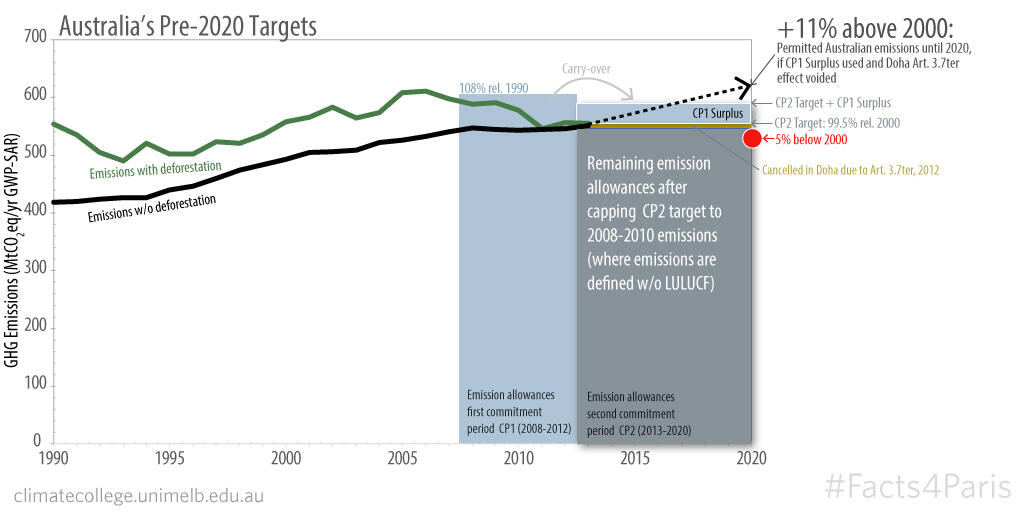Facts4Paris: Australia could meet its Kyoto pledge while increasing emissions 11% by 2020 relative to 2000.

The near-term Australian target is a reduction of 5% on 2000 levels by 2020...or so most Australians believe.
In reality the target was established in three parts: an unconditional 5% target; increased to a 15% target if there is a commitment from major developing economies to substantially reduce emissions and for advanced economies to take on comparable commitments; increased to a 25% target if the global agreement can stabilise emissions levels at 450 parts per million or less.
According to the Climate Change Authority, requirements for the 15% target have been met.
But there is a technical point that comes into play here as well. It is such that the actual legal obligations under the Kyoto Protocol are potentially weak enough that Australia may be able to increase its emissions by 11% above 2000 levels and still be in compliance. This all has to do with three factors:
- The target under the Kyoto Protocol is not a end-target of 5% below 2000 levels. It is in fact an annual target of reducing emissions by 0.5% (yes: 0.5%) below 2000 levels over the 2013-20 period.
- At the end of the first commitment period of the Kyoto Protocol, Australia was left with a large surplus of emission credits (something like 250 to 300 MtCO2eq) that it may choose to carry over. Australia could use these surplus credits over the 2013 to 2020 period under certain conditions (basically they can be used, if emissions are higher than the target).
- The third factor may or may not be a factor—this is yet to be determined. It centres on a new clause in the Kyoto Protocol, so-called Article 3.7ter. This new clause says that any target in the second commitment period is capped at average 2008-10 emissions. But there is ambiguity in the interpretation of the word 'emissions'. Article 3.7ter was inserted into the text of the Kyoto Protocol itself, so it would most likely be defined using the Kyoto Protocol definition. This definition restricts the meaning of 'emissions' to so-called 'Annex A emissions'. Annex A emissions are emissions resulting from fossil and industrial sources only. It does not include emissions from deforestation. This is pretty much standard accounting practice under the Kyoto Protocol. Except that there was an exception negotiated for Australia: since 2008 Australia has benefitted from special treatment allowing the country to include deforestation emissions in its base-year calculations. It is now in Australia's interest to negotiate for 'emissions' under article 3.7ter to be defined as "emissions including deforestation emissions" (see Australia's submission here). If Australia is successful in this, it would be able to increase its emissions linearly from current levels to 11% above 2000 levels by 2020 and still meet its obligations under the Kyoto Protocol. If Australia is unsuccessful, and the term 'emissions' continues to refer to 'Annex A emissions', then Australia will have to keep its emissions constant (at least) until 2020.
Discussions on the definitions of Article 3.7ter may not be the main game in Paris in December, but they will definitely be part of the horse-trading going on in the backrooms.
Update 5th December: That horsetrading has happened now. Australia backs 1.5C target as part of the Paris agreement and is in turn allowed to increase its emissions by up to 11% above 2000 levels by 2020. See here: http://www.smh.com.au/environment/un-climate-conference/paris-un-climate-conference-2015-australia-backs-target-of-limiting-warming-to-15-degrees-20151204-glg5dc.html